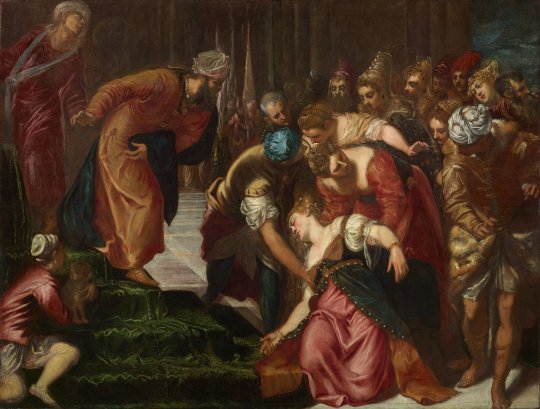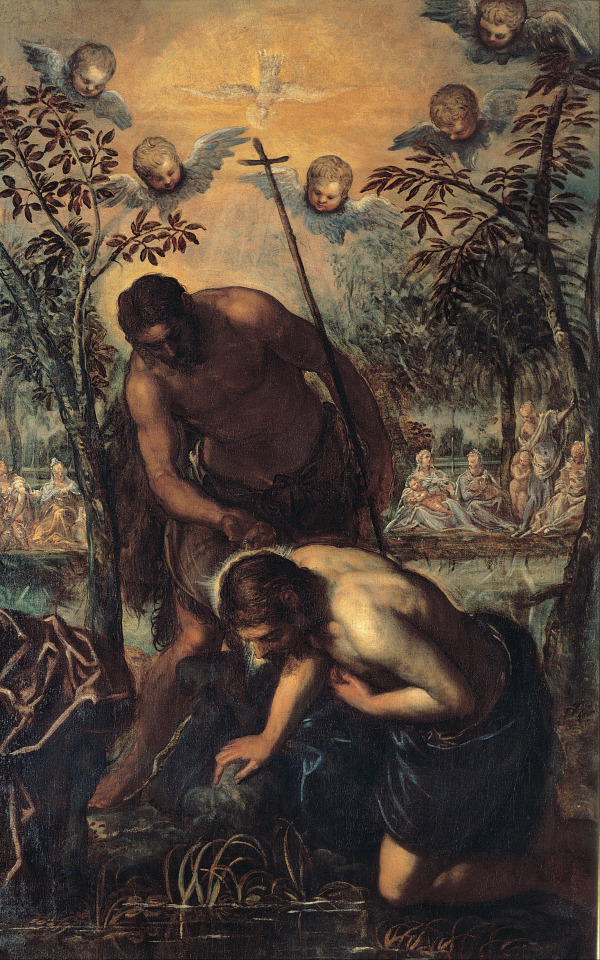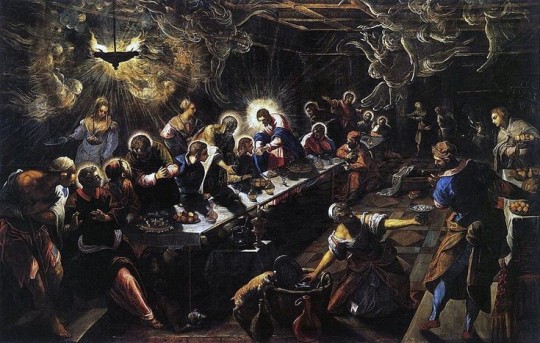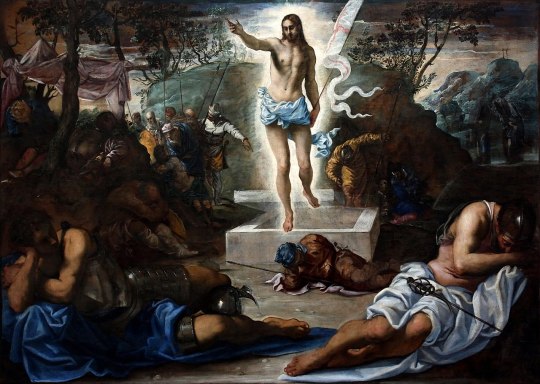#jacopo tintoretto
Explore tagged Tumblr posts
Text

Ecce Homo or Pontius Pilate Presenting Christ to the Crowd
Artist: Jacopo Tintoretto (Venetian, 1519–1594)
Date: 1546-1547
Medium: Oil on Canvas
Collection: São Paulo Museum of Art, São Paulo, Brazil
Ecce Homo
"Ecce Homo" is a Latin phrase meaning "Behold the Man," and it refers to the moment in the Bible where Pontius Pilate presents Jesus, crowned with thorns, to the crowd before his crucifixion, saying these words as a gesture of defiance to the Jewish leaders demanding his execution; essentially asking them to "behold the man" they want crucified; it is a common theme in Christian art, depicting Jesus in a suffering state with the crown of thorns.
John 19:5
So Jesus came out wearing the crown of thorns and the purple robe. Pilate said to them, “Behold the man!��
#ecce homo#passion of christ#christianity#bible scripture#bible story#holy bible#jesus#pontius pilate#crowd#roman soldiers#italian renaissance#jacopo tintoretto#venetian#16th century painting#biblical#biblical art#gospel of john
31 notes
·
View notes
Text

The Origin of the Milky Way, 1575-1580
Jacopo Tintoretto
20 notes
·
View notes
Text

The descent from the cross, Jacopo Tintoretto, 1586-90
#gallerie dell'accademia#venezia#venice#jacopo tintoretto#16th century#descent from the cross#art history#art#aesthethic#italian art#venetian art#rinascimento#painting#religious art
20 notes
·
View notes
Text

Esther Before Ahasuerus by Jacopo Robusti, called Il Tintoretto
Italian, c. 1546-1547
oil on canvas
Royal Collection Trust (acquired by King Charles I)
#Esther#Ahasuerus#Jacopo Robusti#Tintoretto#Jacopo Tintoretto#Museums have a bunch of ways of referring to him and my previous posts are inconsistent#which is really bugging me but I haven't decided which I like best#Biblical painting#art#painting#Renaissance#Mannerism#Italian#Venetian#Venetian School#Royal Collection Trust
30 notes
·
View notes
Text

Jacopo Tintoretto: Retrato dun mozo cunha escultura de Lucrecia (ca. 1555)
7 notes
·
View notes
Text

Jacopo Tintoretto, Baptism of Christ
"Christian Year contains two central cycles – the Easter cycle and the Christmas cycle... preceded by a season of preparation and anticipation (Lent and Advent)... Lent and Advent are immediately preceded by a transitional Sunday (Transfiguration and Christ the King), and the Easter and Christmas Seasons are immediately followed by a transitional Sunday (Trinity and Baptism of the Lord)."- Liturgical Year
5 notes
·
View notes
Text

Pieta, 16th century by Jacopo Tintoretto (1518-1594), oil on canvas 194,4x103 cm. Kasan
#art#italian art#italian painter#venetian school#16th century#religious art#pieta#jacopo tintoretto#museum#kasan
3 notes
·
View notes
Text

The wision of Ezekiel, 1578 by Jacopo Tintiretto (1518-1594)
#art#italian art#venetian school#italian painter#renaissance#16th century#religious art#jacopo tintoretto#1578
6 notes
·
View notes
Text

Jacopo Tintoretto, The Baptism of Christ, 1585. Oil on canvas
43 notes
·
View notes
Text

Jacopo Tintoretto - The Murder of Abel, between 1550 and 1553.
16 notes
·
View notes
Text

Portrait of Marino Grimani
Artist: Jacopo Tintoretto (Italian, 1519–1594)
Genre: Portrait
Date: 1578
Medium: Oil on Canvas
Collection: Los Angeles County Museum of Art
Marino Grimani (1 July 1532, in Venice – 25 December 1605, in Venice) was the 89th Doge of Venice, reigning from 26 April 1595 until his death.
#dodge of venice#republic of venice#portrait#jacopo tintoretto#italian painter#16th century venice#landscape#marino grimani
2 notes
·
View notes
Text

The Meeting of Tamar and Judah
Artist: Jacopo Tintoretto (Italian, 1519–1594)
Genre: Religious Art
Date: ca. 1555-1559
Medium: Oil on Canvas
Collection: Museo Nacional Thyssen-Bornemisza, Madrid
The Story of Tamar
There are three women named Tamar in Scripture. One Tamar, the beautiful daughter of Absalom, is only mentioned in passing in 2 Samuel 14:27; this Tamar became the mother of Queen Maacah, who married King Rehoboam. The other two Tamars are both tragic figures, women who were ruined by the neglect and abuse of close family members. Their stories seem to be included in Scripture for the purpose of providing historical and spiritual information about the Messianic line.
Jacob’s son Judah, patriarch of the line of Judah had three sons: Er, Onan, and Shelah. A woman named Tamar married Er, but then Er died, leaving her a widow. Since it was required that the next of kin care for a brother’s widow, Tamar was given to Onan, but he also died. Shelah was still a boy and could not marry Tamar, so Judah asked her to return to her father’s house and wait until Shelah was grown up. However, once Shelah was old enough, Judah did not honor his promise. Tamar remained an unmarried widow. Tamar then went into town disguised as a prostitute, tricked Judah, and got him to sleep with her. She then became pregnant by Judah and bore twin sons named Perez and Zerah. The story is recorded in Genesis 38.
Who was Judah?
Judah was the fourth son of Jacob with his wife Leah, and the head of one of the 12 tribes of Israel. The other 11 tribes descended from Judah’s brothers and half-brothers.
#religious art#landscape#tamar#judah#old testament#jacopo tintoretto#european#oil on canvas#16th century painting#museo nacional thyssen bornemisza#biblical#christianity#italian painter#book of genesis#christian art
3 notes
·
View notes
Text

Jacopo Tintoretto - The Annunciation to Manoah's Wife
3 notes
·
View notes
Text

The Last Supper (Ultima Cena), 1594 by Jacopo Tintoretto (1518-1594)
28 notes
·
View notes
Text

Jacopo Tintoretto, The Birth of Saint John the Baptist, 1550s x
2 notes
·
View notes
Photo

Jacopo Tintoretto: La Resurrezione
#Tintoretto#Jacopo Tintoretto#Jacopo Robusti#La Resurrezione#The Resurrection of Christ#Oil on Canvas#Painting#Art#Mannerism#Rennaissance#Religious Art#Sacred Art#Christian Art
26 notes
·
View notes